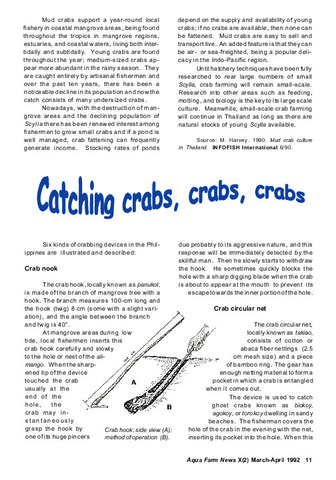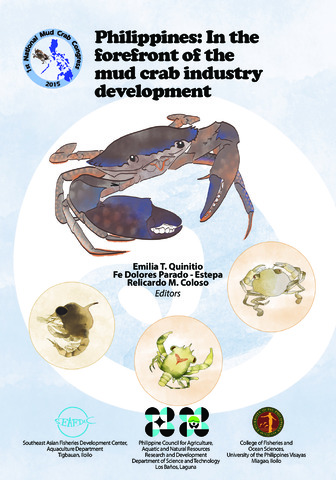Perlihatkan publikasi sederhana
Approaches to stock enhancement in mangrove-associated crab fisheries
| dc.contributor.author | Le Vay, Lewis | |
| dc.contributor.author | Lebata, Ma. Junemie Hazel L. | |
| dc.contributor.author | Walton, Mark | |
| dc.contributor.author | Primavera, Jurgenne | |
| dc.contributor.author | Quinitio, Emilia T. | |
| dc.contributor.author | Lavilla, Celia R. | |
| dc.contributor.author | Parado-Estepa, Fe D. | |
| dc.contributor.author | Rodriguez, Eduard | |
| dc.contributor.author | Ut, Vu Ngoc | |
| dc.contributor.author | Nghia, Truong Trong | |
| dc.contributor.author | Sorgeloos, Patrick | |
| dc.contributor.author | Wille, Mathieu | |
| dc.date.accessioned | 2011-05-13T06:35:18Z | |
| dc.date.available | 2011-05-13T06:35:18Z | |
| dc.date.issued | 2008 | |
| dc.identifier.citation | Le Vay, L., Lebata, M. J. H., Walton, M., Primavera, J., Quinitio, E., Lavilla-Pitogo, C., … Wille, M. (2008). Approaches to stock enhancement in mangrove-associated crab fisheries. Reviews in Fisheries Science, 16(1-3), 72-80. | en |
| dc.identifier.issn | 1064-1262 | |
| dc.identifier.uri | http://hdl.handle.net/10862/32 | |
| dc.description | non-SEAFDEC main author, ISI-CC covered journal. | en |
| dc.description.abstract | Over the last decade, hatchery production of mud crabs has become technically and economically more feasible, enabling evaluation of the potential effectiveness of hatchery release in fisheries enhancement. The high growth rates and limited movement of released crabs means that fisheries’ yields an isolated mangrove systems with restricted recruitment can be enhanced with a few months. Thus, a release program may be an effective strategy for short-term enhancement in carefully selected specific areas. To date, results are very promising; with recovery rates up to 50% and increases in fisheries’ yield up to 46% over baseline catches. In contrast, mark-recapture studies in more open mangrove system populations shows that recruitment success and subsequent stock abundance may be largely determined by habitat availability. For these populations, restoration of lost o degraded mangrove areas has been show to be effective in promoting stock recovery through natural recruitment, with replanted mangroves supporting fisheries of equivalent economic value to that of natural mangroves, though it may take some years to reach these levels. Thus, a balanced approach to stock management could integrate both hatchery-release and habitat restoration programs, depending on local conditions and over different thin scales, with parallel-co-management to support effectiveness. | en |
| dc.description.sponsorship | European Commission through INCO DC contracts ERB-IC18-CT97-0189 and ECA4-CT-2001-10022. | en |
| dc.language.iso | en | en |
| dc.publisher | Taylor & Francis | en |
| dc.subject | Decapoda | en |
| dc.subject | Scylla | en |
| dc.subject | Mud crabs | en |
| dc.subject | replanting | en |
| dc.title | Approaches to stock enhancement in mangrove-associated crab fisheries | en |
| dc.type | Article | en |
| dc.identifier.doi | 10.1080/10641260701727285 | |
| dc.citation.volume | 16 | |
| dc.citation.issue | 1-3 | |
| dc.citation.spage | 72 | |
| dc.citation.epage | 80 | |
| dc.citation.journalTitle | Reviews in Fisheries Science | en |
| dc.subject.asfa | crab fisheries | en |
| dc.subject.asfa | fishery management | en |
| dc.subject.asfa | growth rate | en |
| dc.subject.asfa | habitat improvement | en |
| dc.subject.asfa | mangroves | en |
| dc.subject.asfa | potential resources | en |
| dc.subject.asfa | recruitment | en |
| dc.subject.asfa | tracking | en |
| dc.subject.asfa | hatcheries | en |
Files in this item
| Files | Size | Format | View |
|---|---|---|---|
|
There are no files associated with this item. |
|||
Publikasi ini ada di koleksi berikut
-
Journal Articles [1258]
These papers were contributed by Department staff to various national and international journals.



